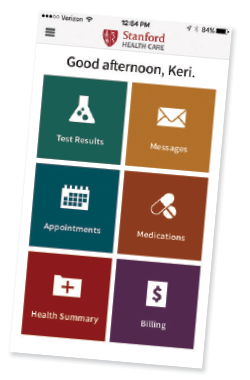
Image Credit: pedrosek/shutterstock.com
Patient portals are online programs and applications that help patients and physicians interact. Although there are many different implementations, most will have some sort of messaging component to help with communication between the doctor and the patient, as well as access to at least some elements of the chart, such as test results.
“Patients should expect to have access to their health data just as they have access to book their airplane flights, do their banking online and go shopping with immediate delivery,” says John Sharp, senior manager, Health Information Systems Consumer Health IT with Healthcare Information and Management Systems Society (HIMSS) in Chicago. “It should be done to not only improve the patient’s experience, but also to engage the patient in their care.”
Portals & Meaningful Use
Portals are becoming something every physician will have to deal with sooner or later. The information delivered by them will be an integral part of qualifying your electronic medical record (EMR) systems for reimbursement under the terms of meaningful use rules.
“We really did not decide to set up a portal, it came with our new EMR and was required under meaningful use rules,” says Jennifer Odutola, MD, with the Loudoun Rheumatology Center in Lansdowne, Va. “We are just so bogged down with new things; I am not sure I would have gone out of my way on my own.”
After installation, she has found that having a patient portal allows patients to communicate and express themselves in a manner that can’t be misinterpreted as it goes up the line. It has improved the accuracy of communication, especially when compared with the telephone.
“We have found it very nice for patients to be able to communicate in ways other than on the telephone,” she says. “There may be a more satisfied patient [because] they have the comfort of a relatively quick turnaround on their questions. For someone who is angry, this is a great way to rebuild the relationship.”
Access to Labs & Tests
A portal has also proved useful to the practice by giving patients access to their laboratory and other test results. Although it does mean you occasionally have to discuss these results with patients between appointments, she finds that many of her longer term patients know what the numbers mean and can access them when they want to review results.

Dr. Odutola
“It tends to help with medicine reconciliation,” says Dr. Odutola. “They can look at the list on the portal and easily let me know that they are not taking a medication any more or that another doctor has added one to the regimen.”
She noted that she gets two or three communications a day from patients. Some talk about things that could have waited until the next appointment. Others bring up things that should be addressed quicker or need to be talked about in person before the next scheduled visit.
“On a busy day this extra work can be stressful,” she says. “But patients love the quicker access.”

The patient portal above, MyHealth, is offered by Stanford Health Care. Patients can easily review orders, update medications ordered by non-network physicians, review test results and more.
Third Party or Part of Your EMR
For most, a patient portal comes along with your EMR system. Some practices may find that what they have does not fit in with their needs. It is obvious that comfort with the medical records piece often is a higher priority in these decisions.

Mr. Sharp
“There are pros and cons to having your own portal,” says Mr. Sharp. “If you have your own portal, you can choose the features you want, and it makes it easier to brand it to your practice.”
This is balanced against the need for patient and practice ease of use. For those who share their EMR with an area hospital, it is often easier, and less expensive, to use its portal. You get the hospital’s IT resources to answer questions and deal with problems, and you don’t have to pay for expensive data integration programs if there are interoperability problems. The practice may also have higher use of the portal because the patient doesn’t need to remember yet another password and user name combination.
“Product choices are varied,” says Mr. Sharp. “Many EMR vendors have their own portals available as an add-on feature. However, the practice still needs to make sure that the registration process is easy, it is secure, and the interface is easy to use. This means fewer phone calls about problems and increases the likelihood that patients will use it more than once.”
Third-party portals are available that can connect to the practice’s EMR and draw out basic data. Some smaller companies may be more service oriented for small practices.
Privacy Issues
There is no requirement that a practice request permission from a patient to put their information on a patient portal under the Health Insurance Portability and Accountability Act of 1996 (HIPAA). The Act lets patients access their own data without needing extra paperwork.
However, it also requires the practice to put in safeguards to make sure nobody other than the patient or others they have authorized can see the protected health information. Check with your vendor to make sure that privacy and security safeguards are in place and up to HIPAA requirements.
Among the measures suggested to make sure the patient who is accessing a portal is who they say they are include:
- Unique user IDs and passwords;
- Two-factor authentication (for example, a code being sent to a cell phone in addition to a password);
- Patient education on appropriate use of the portal and the importance of safeguarding their login credentials; and
- Patient education on securely storing any information they download or print.
Although records must be secure, experts suggest that complex password requirements could actually have the effect of denying access to the patient. Assess your practice population and ensure the login requirements aren’t so strong that your users can’t get onto the portal in the first place.
There should also be a comprehensive user agreement that the patient signs and/or clicks on outlining the responsibilities of both parties. This is probably something the practice should consider running past an appropriate attorney. It needs to walk a relatively fine line between protecting the practice while not denying the patient access to their personal healthcare information.

Mr. Yaskin
Staffing issues will need to be addressed by the practice. Someone from your office, vendor or affiliated hospital, if you are using theirs, will need to be on the help desk to answer questions and handle lost password and user name requests.
One staffing concern that is not often considered is compliance with HIPAA’s Right of Amendment. This gives patients the ability to request changes in their records. Some have seen a 100% increase in these requests running from the frivolous (spelling mistakes) to major corrections, such as showing the rheumatoid arthritis was in the left knee instead of the right.
Stimulating Patient Use
After you have the portal available, the next question is how to get your patients to actually use it. Simply offering the option is the first, fairly tentative step in the process. To meet meaningful use standards, a certain number of your patients must use it.
“It’s really up to the doctors to let their patients know this service is available to them, says Steve Yaskin, CEO of Health Gorilla, a third-party clinical platform that connects patients with their doctors and relevant clinical data. “Often, they put the website address and sign-on instructions at the front desk.”
Portals may lead to ‘a more satisfied patient [because] they have the comfort of a relatively quick turnaround on their questions. For someone who is angry, this is a great way to rebuild the relationship.’ —Dr. Odutola
Generally, the best time to sign people up is when they are in the examination room. The doctor should bring it up by suggesting they get the information on laboratory results. It is also a good time to point out that hooking up with the portal lets patients make appointments and get access to informational materials immediately if they find later that they don’t remember or understand part of the patient instructions.
Mr. Sharp suggests that successful adoption by patients requires a few simple steps:
- An easy registration process;
- Taking the time to educate your patients about the value of easy access to their own data;
- A tutorial or other method to show them how to use the portal. As with other instructions, giving them something to have with them at home could be useful;
- Having a help desk available to answer questions or reset the almost inevitable lost password; and
- Offering valuable patient education materials about their specific condition in a way that makes it easy to find.
Allowing patients to make their own appointments is another inducement that many will find useful. After all, when you book a hotel room online, you know without any wait that your reservation has been accepted.
Make sure that all handouts and other information distributed to patients have the Web address printed on them. Signs in the exam rooms and the waiting areas should be available with instructions on how to sign on. Some have suggested having a computer in the waiting room with a sample portal so patients can use it and become comfortable with it before they leave the office.
Demographics Important
Looking at the demographics of your practice is another important aspect when deciding how to run your portal.
“Recent studies have shown no major differences in the age groups in the interest and use of portals,” says Mr. Sharp. “[Although] the younger groups may be more tech savvy, other age groups are increasingly using the Internet, mobile devices and apps. Remember that many in the older generation are motivated technically by the desire to see photos and videos of the grandchildren.”
He notes two exceptions that those designing and working with a portal should keep in mind: the very old (85+) and those who have never used computers. The second group is healthy, but remains Internet illiterate. You will need to find alternate ways to communicate with both of these.
“One way to involve the elderly is to establish contact with their children or grandchildren who are more computer oriented,” says Mr. Yaskin. “You can establish what we call ‘care circles,’ where others who are cleared by the patient can access the portal on their behalf.”
This isn’t really all that different from having another person in the exam room with the patient. This could also be extended to the healthy group with no computer access. In both cases, more traditional means, such as telephone or U.S. mail, may be needed.
Especially in the early stages of adoption, the practice may want to focus resources on the patients who would benefit the most from the services offered on a patient portal. Those with multiple medications or complex diagnosis who require regular blood work and procedures would be one example.
Adolescent Patients
Another concern for some practices will be how to best work with their adolescent populations. At what age should the patient be allowed to take over their own care, and to what extent can the parent be excluded without consent of the child? These decisions may be driven as much by custom and law as the desires of the practice.
“In the end, a portal improves the quality of service to the patient,” says Dr. Odutola. “Does it make it easier? On that point, I am not so sure.”
Kurt Ullman is a freelance writer based in Indiana.
For More Information…
Further information on the ins and outs of starting and maintaining patient portals can be found at:
- The California Healthcare Foundation and their Patient Portal Resource Center.
- Office of the National Coordinator for Health Information Technology, U.S. Department of Health and Human Services: Search on patient portals
- Healthcare Information and Management Systems Society (HIMSS), Patient Engagement Resource Library.